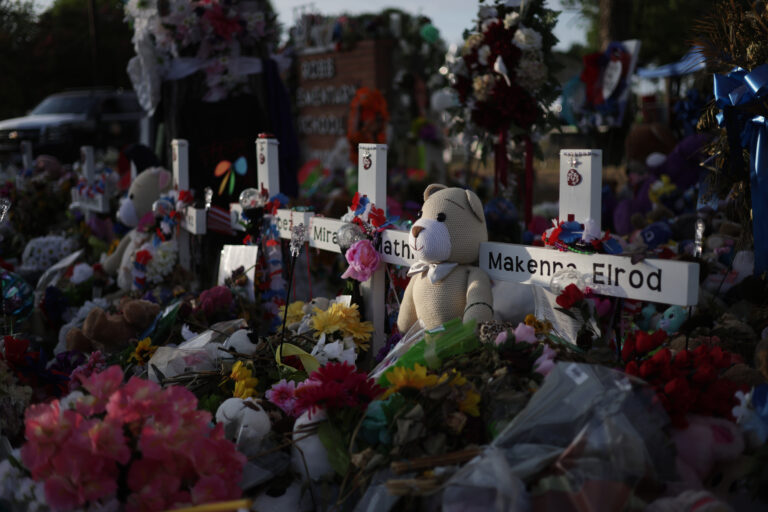Flowers, plush toys and wooden crosses are placed at a memorial dedicated to the victims of the mass shooting at Robb Elementary School in Uvalde, Texas, on June 3, 2022. Nineteen students and two teachers were killed on May 24, 2022, after an 18-year-old gunman opened fire inside the school. (Photo by Alex Wong/Getty Images)
WASHINGTON — The devastating effects of school shootings continue well after shootings occur, according to survivors, experts and educators who spoke at a roundtable U.S. House Oversight and Reform Committee Democrats held Monday.
Democrats scheduled the discussion after the recent school shooting in Georgia, where two students and two teachers were killed. Witnesses told the panel the psychological trauma of a school shooting lingers long beyond the events themselves.
“In the months and years after a mass shooting, young people injured or wounded in the attack experience continuing fear, pain, trauma and disorientation, and struggle to hang on to what is left of their lives,” the top Democrat on the committee, Maryland Rep. Jamie Raskin, said.
The roundtable came just after the one-year anniversary of the White House establishing its Office of Gun Violence Prevention. President Joe Biden and Vice President Kamala Harris are scheduled to speak about gun violence at the White House Thursday.
There have been 404 mass shootings this year, according to the Gun Violence Archive, a group that studies gun violence in the U.S.
Several educators at the roundtable advocated for Congress to provide more funding for schools to address the long-lasting effects of a school shooting.
“There’s not a time period when the trauma is going to disappear,” Frank DeAngelis, who was the principal of Columbine High School during the 1999 mass shooting in Colorado, said.
DeAngelis is also a founding member of the National Association of Secondary School Principals Principal Recovery Network, which is a network to help educators in the aftermath of a school shooting.
Greg Johnson, a principal at West Liberty-Salem High School in West Liberty, Ohio, said that even though no student died at his school’s shooting in 2017, students and faculty had lasting trauma.
“Hundreds of students heard the piercing shotgun blasts, and those same hundreds barricaded the doors of their classrooms before they evacuated and in random ditches and across fields in search of safety,” he said. “Many were traumatized, though almost all tried their very best to hide it by putting on a mask of strength and normalcy. Our students suffered in silence.”
Sarah Burd-Sharps, the senior director of research at Everytown for Gun Safety, added that the economic cost of gun violence is estimated at more than $550 billion a year.
Mental health funding
Patricia Greer, principal at Marshall County High School in Benton, Kentucky, said that while the bipartisan gun safety bill that Congress passed in 2022 provided substantial funding for mental health, Congress should consider increasing such funding to help students and staff recover from trauma.
“Schools are uniquely positioned to provide mental health support, but they need our help to meet the growing demand,” Greer said.
She pushed for Congress to consider increasing funding for Title II and Title IV to support professional development for educators and expand school-based mental health services. Those titles refer to the Elementary and Secondary Education Act, which provides federal grants to schools.
“Recovery requires sustained support and resources,” she said. “By increasing funding for … Title II to $2.4 billion, and Title IV to $1.48 billion, we can provide schools with the resources they need to prevent tragedies and support students through trauma.”
Melissa Alexander, whose son survived the Covenant School shooting in Nashville, Tennessee, said “a mass shooting is not something you get over.”
She said her then 9-year-old son called her during the shooting, begging for her to save him.
“He prepared to die,” she said.
Alexander, who is now a firearm safety advocate, said that even though she is in a deep-red state, nearly 75% of residents support some type of red flag laws. Such laws allow courts to order the temporary removal of a firearm from people at risk of harming themselves or others.
Despite the widespread support, state lawmakers have not taken action, she said.
“It’s not translating up to the (state) Legislature,” she said.

